
A Regional
Research and Monitoring Program for Commercially - Harvested Edible Forest
Mushrooms
David Pilz and Randy Molina
Pacific Northwest Research Station
US Department of Agriculture, Forest
Service

A Regional
Research and Monitoring Program for Commercially - Harvested Edible Forest
Mushrooms
David Pilz and Randy Molina
Pacific Northwest Research Station
US Department of Agriculture, Forest
Service
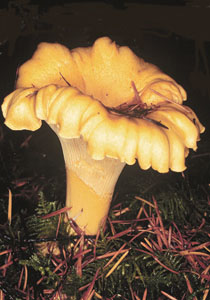 |
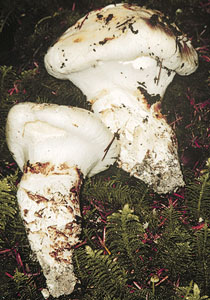 |
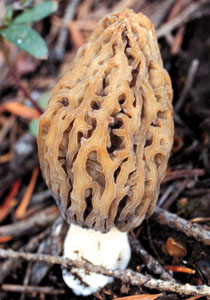 |
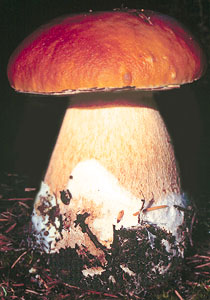 |
| Cantharellus formosus
"Pacific golden chanterelle" |
Tricholoma magnivelare
"American matsutake" |
Morchella species
"Black morel" |
Boletus edulis
"King bolete" |
The forests of the Pacific Northwest
are rich with diverse fungi and abundant edible mushrooms. During
the last decade, forest managers have expanded their appreciation of this
resource as they begin to grapple with the twin issues of rare fungi associated
with decreased old-growth forest 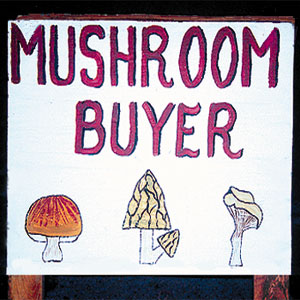
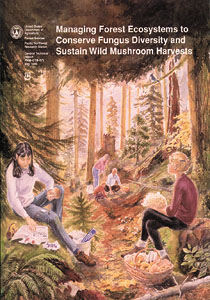 habitat
and edible mushrooms that are commercially collected in large quantities.
Both issues are especially important on public forests managed by the Forest
Service (US Department of Agriculture) and Bureau of Land Management (US
Department of Interior). Federal lands encompass a large proportion
of forest mushroom habitat in the Pacific Northwest, and these agencies
are mandated to conserve biological (fungus) diversity and provide opportunities
for the sustainable harvest of commercial products (edible mushrooms).
Early efforts to address these issues are summarized in "Managing forest
ecosystems to conserve fungus diversity and sustain wild mushroom harvests"
(Pilz and Molina, 1996), a free General Technical Report (PNW-GTR-371)
published by the Pacific Northwest Research Station.
habitat
and edible mushrooms that are commercially collected in large quantities.
Both issues are especially important on public forests managed by the Forest
Service (US Department of Agriculture) and Bureau of Land Management (US
Department of Interior). Federal lands encompass a large proportion
of forest mushroom habitat in the Pacific Northwest, and these agencies
are mandated to conserve biological (fungus) diversity and provide opportunities
for the sustainable harvest of commercial products (edible mushrooms).
Early efforts to address these issues are summarized in "Managing forest
ecosystems to conserve fungus diversity and sustain wild mushroom harvests"
(Pilz and Molina, 1996), a free General Technical Report (PNW-GTR-371)
published by the Pacific Northwest Research Station.
Air pollution and intensive forest management (leading to declines in forest health and simplified forest ecosystems) are thought to be major contributors to decreased mushroom diversity and productivity in Europe (Arnolds 1991). In the Pacific Northwest, climate change, pollution from growing urban areas, ozone depletion, introduced pathogens, and intensive timber harvesting may also be detrimental to forest health and thus impact edible mushroom production. Initial studies of the impacts of edible mushroom picking have concluded that careful harvesting does not diminish subsequent fruiting (Egli and others 1990, Norvell and others 1995), but these small-scale studies have not adequately addressed the impacts of large-scale commercial mushroom harvesting or forest management activities over long periods of time.
We propose a regional approach to
edible forest mushroom monitoring and research in the Pacific Northwest
(and potentially elsewhere) that is designed to be systematic, statistically
sound, modular, and voluntary. Cooperation among landowners, forest
managers, scientists and interested publics (for instance, mycological
societies and commercial mushroom harvesters) will be integral to its success.
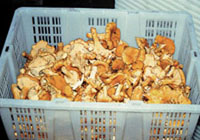 |
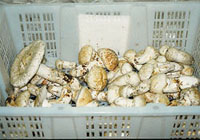 |
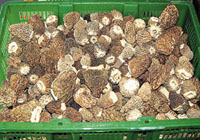 |
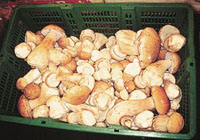 |
- The Pacific Northwest region
of the North American continent is one of the best places for conserving
genetically diverse populations of temperate coniferous forest fungi because: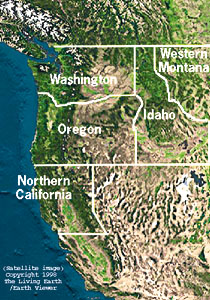
The region is characterized by myriad
ecological niches with locally adapted fungi.
Numerous areas retain native forests with a mycota that has, so far, not been strongly influenced by human activities.
- The USDA Forest Service
and USDI Bureau of Land Management have begun implementing regional monitoring
programs for rare fungi associated with old-growth forest habitat, but
no comparable regional monitoring of edible mushrooms yet exists.
Commercial harvest of edible forest mushrooms is now a large, wide-spread,
regional industry, but current site-specific research and monitoring projects
are inadequate to ensure sustainable harvesting throughout the region.
- Factors that have lead to declines in edible forest mushroom production elsewhere are starting to impact forests in the Pacific Northwest; hence regional trends in fruiting of edible ectomycorrhizal mushrooms may indicate shifting mycorrhizal relations and associated changes in forest health.
- Maintaining or enhancing appropriate habitat is the most important factor in guaranteeing the viability of fungus populations and providing future opportunities for sustainable harvest of edible mushrooms. Forest types and age classes will shift across the landscape in the coming decades and centuries as a result of natural disturbances and forest management activities. In order to maintain connectivity of habitat for reproductive dispersal and provide continuously available harvest opportunities for the public, edible mushroom occurrence and production must be quantified in various ecological habitats and stand conditions. This information must then be incorporated into long-range ecosystem management plans.
- A regional research and monitoring program is cost-effective because it shares work and expense among cooperators, avoids unnecessary duplication of field sampling, and allows landscape or regional inferences about noted fruiting trends, habitat correlations, or forest management activities.
- Public participation in
program design and field sampling will lower agency costs, improve understanding
of monitoring goals and methods, enhance communication between public land
management agencies and user groups, and increase confidence in the results.
- Low-intensity, long-term monitoring of areas with heavy commercial harvesting to ensure harvest sustainability and evaluate reasons for potential trends.
- Low-intensity, long-term monitoring of natural areas (where neither timber nor mushroom harvesting occurs) to provide control sites for interpreting trends in commercially harvested areas and to detect trends related to regional changes in the environment or forest health.
- Intensive, short-term research on correlations between mushroom productivity, habitat, and stand management activities to provide forest managers with the information needed to ensure future habitat availability and mushroom collection opportunities.
- Use development of this
research and monitoring program as a prototype for cost-effectively ensuring
the sustainable harvest of an array of other nontimber forest products
by engaging interested publics in research and monitoring activities.
Ectomycorrhizal mushrooms fruit
in clusters and several flushes may occur during a season. Hence,
to obtain reasonably precise estimates of edible mushroom production on
a site, areas 0.4 ha (1 acre) or greater must be repeatedly sampled during
the course of a fruiting season. Long, narrow strip plots (transects)
have several practical advantages over circular or square plots, especially
in brushy terrain. Hidden mushrooms are more readily found (detection
error is reduced) when two individuals search from opposite sides of the
plot. Soil and vegetation trampling that results from repeated sampling
during a season is lessened by spreading the impact linearly and, if the
plots are 2 meters wide or less, personnel can avoid walking on the plots
entirely. Field personnel also find it easier to remember where
they have already searched in linear plots than in large circular or square
plots.
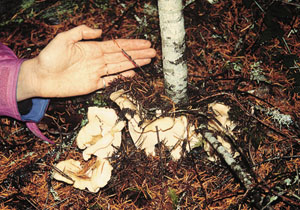 |
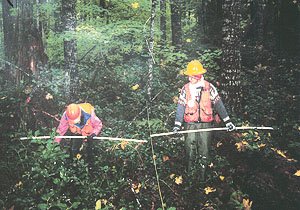 |
Although most edible mushrooms are
easily recognized, life histories and species concepts may still pose some
challenges to monitoring program design. For instance,
several types of morels are commercially collected in the Pacific Northwest
and their taxonomic identities are not yet fully resolved. Recent
evidence suggests some may be facultatively mycorrhizal and fruit regularly
in non-disturbed forests, while others are likely saprobic and fruit in
flushes following disturbances such as fire or logging. Likewise,
several species of chanterelles are commercially collected in the region,
but their taxonomic identities are still being genetically examined.
Voucher specimens from monitoring sites will allow productivity values
to be linked with emerging species distinctions and corresponding ecological
adaptations.
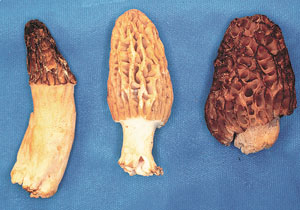 |
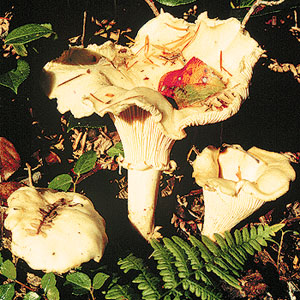 |
- Voluntary participation by interested agencies, organizations or individuals
- Landowner and public participation in program design
- Start with matsutake, chanterelles, morels, and king boletes (other species?)
- Common, tested, core sampling procedures
- Modular sampling protocols (optional sampling for cooperator-specific goals)
- Common, coordinated, site selection criteria
- Common meta-data (sampling protocols, habitat, stand type, weather, events, etc.)
- Cooperators assume responsibility for maintaining and sampling sites
- Periodic training in sampling procedures (on-going as needed for new personnel)
- Cross-checking among cooperators to assure data quality
- Institutional and financial arrangements to support long-term monitoring
- Annual reports, periodic analyses, prompt posting of results to a web site
- Periodic program review and revision
Many other species of edible mushrooms
are commercially collected in the Pacific Northwest, and the number is
increasing as customers become more informed and adventurous. Monitoring
less commonly collected species will depend on the willingness of interested
individuals, organizations, and landowners to invest the time, money and
effort. The voluntary and modular nature of the proposed monitoring
program will accomodate species of interest to cooperators.
 |
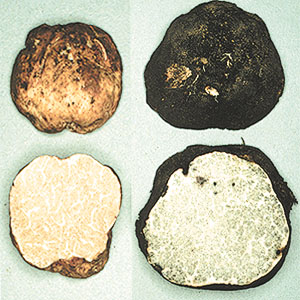 |
 |
| Hydnum repandum
“Hedgehog” |
Tuber gibbosum
and
Leucangium carthusianum “Oregon white and black truffles” |
Hypomyces lactifluorum
parasitizing Russula species “Lobster mushroom” |
Scientists: PNW Research Station (Project design and implementation, training, data management, scientific analyses, and reports.)
Land Managers: USDA and USDI. Also any public or private forest landowner with appropriate sites and interest in the project. (Provide the majority of field sites and personnel managers. Collect field data.)
Public: Mycology clubs, commercial
harvesters, and other interested individuals or organizations (Input on
project design, periodic critique of program, collecting field data.)
While the envisioned monitoring
program is ambitious and entails many challenges, our greatest asset is
the large community of mushroom lovers that have a deep appreciation for
fungi. The development of this program will rely on their enthusiasm,
hence we are optimistic about its success.
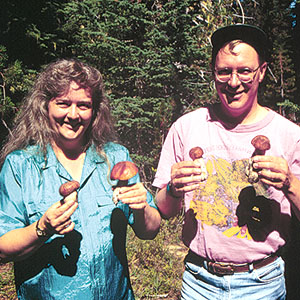 |
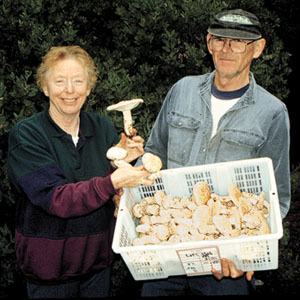 |
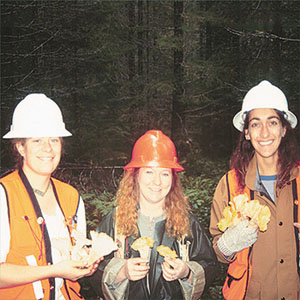 |
Arnolds, E. 1991. Decline of ectomycorrhizal fungi in Europe. Agriculture, Ecosystems and Environment. 35: 209-244.
Egli, S.; Ayer F.; Chatelain, F. 1990. Der Einfluss des Pilzsammelns auf die Pilzflora. Mycologia Helvetica. 3(4): 417-428.
Norvell, L.; Kopecky, F.; Lindgren, J.; Roger, J. 1995. The chanterelle (Cantharellus cibarius): a peek at productivity. In: Schnepf, Chris, comp.; ed. Dancing with the elephant: Proceedings: The business and science of special forest products--a conference and exposition; 1994 Jan. 26-27; . Hillsboro, OR. [Place of publication unknown]: University of Idaho Extension Service: 117-128. Sponsored by: Northwest Forest Products Association; Western Forestry and Conservation Association.
Pilz, D.; Molina, R. 1996.
Managing forest ecosystems to conserve fungus diversity and sustain wild
mushroom harvests. Gen. Tech. Rep. PNW-GTR-371. Portland, OR:
U. S. Department of Agriculture, Forest Service, Pacific Northwest Research
Station. 104 p.
Chanterelle mushroom
productivity responses to young stand thinning